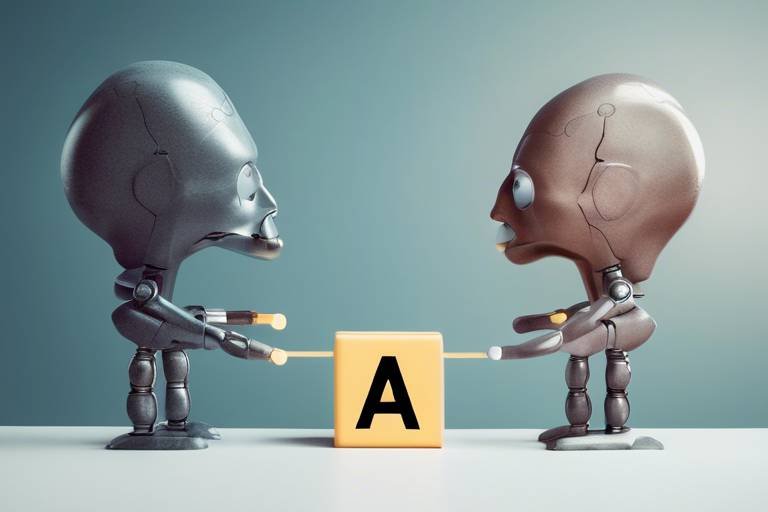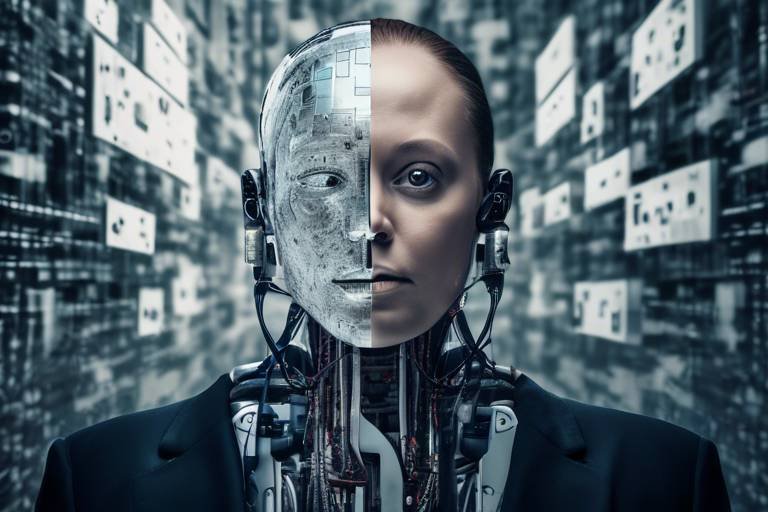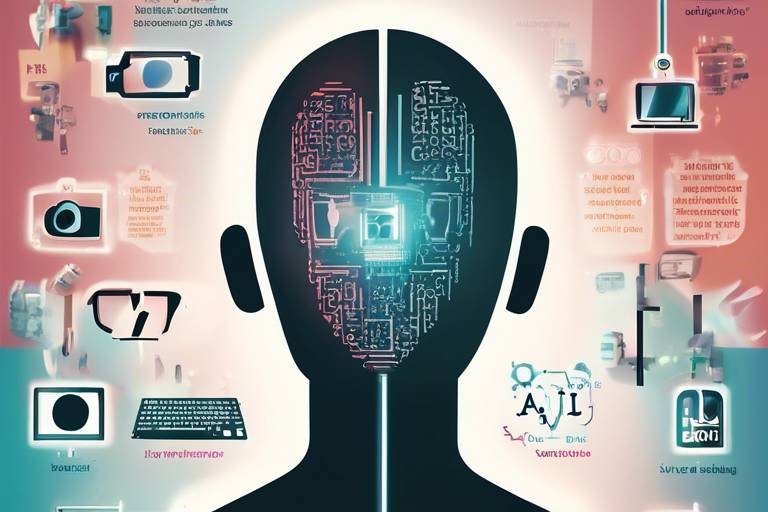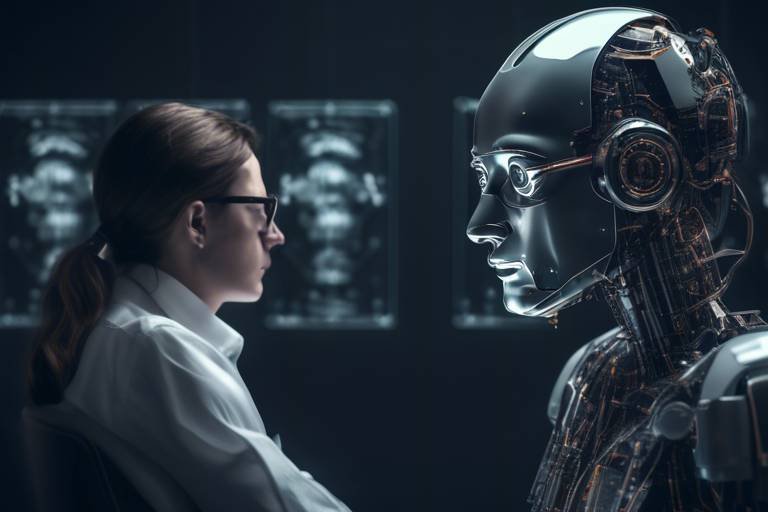Constructive Conversations on AI and Ethics
In our rapidly evolving digital landscape, the intersection of artificial intelligence (AI) and ethics is more crucial than ever. As AI technologies become integrated into our daily lives, they bring with them a myriad of ethical considerations that demand our attention. The complex relationship between AI and ethical principles is not just a topic for tech enthusiasts; it's a conversation that affects everyone. Imagine AI as a powerful tool—like a double-edged sword—that can either enhance our lives or lead us down a problematic path if not handled with care.
So, why should we engage in constructive conversations about AI and ethics? The answer lies in our collective responsibility to ensure that technology serves humanity positively. By fostering open dialogue, we can navigate the challenges posed by AI, ensuring that its development aligns with our shared values. This article aims to explore the intricacies of AI ethics, shedding light on the importance of embedding ethical principles in AI development, the challenges we face, and the need for comprehensive regulatory frameworks.
As we embark on this journey, consider this: what happens when machines start making decisions that impact our lives? How do we ensure that these decisions are fair, transparent, and accountable? These questions are at the heart of the discussions we must have. Engaging in constructive conversations allows us to not only identify the potential pitfalls of AI but also to celebrate its benefits when it is developed ethically.
Ultimately, the goal is to create an environment where AI technologies can flourish while adhering to ethical standards that protect and empower individuals. By prioritizing dialogue and understanding, we can pave the way for a future where AI works for everyone, not just a select few. Join us as we delve deeper into the significance of ethical AI and the challenges that lie ahead.
Ethical AI ensures that technology serves humanity positively. This section discusses the significance of embedding ethical principles in AI development to prevent harmful consequences and promote fairness.
AI ethics faces numerous challenges, including bias, accountability, and transparency. This section examines these obstacles and the implications they have for developers and users alike.
Bias in AI systems can lead to unfair outcomes. This subsection analyzes how biases are introduced and the importance of addressing them to create equitable AI solutions.
Understanding the sources of bias is crucial for mitigation. This part delves into data selection, algorithm design, and societal influences that contribute to biased AI outcomes.
Strategies for mitigating bias in AI are essential. This section outlines best practices for developing fairer AI systems, including diverse data sets and inclusive design processes.
Establishing accountability in AI development is vital for ethical practices. This subsection discusses the roles of developers, companies, and policymakers in ensuring responsible AI use.
Effective regulatory frameworks are necessary to govern AI technologies. This section explores existing regulations and the need for comprehensive policies that address ethical concerns in AI deployment.
Different countries approach AI regulation uniquely. This subsection compares global regulatory perspectives and their implications for international cooperation in AI ethics.
Public engagement is critical in shaping AI ethics. This section highlights the importance of involving diverse voices in discussions about AI's ethical implications and societal impact.
- What is AI ethics? AI ethics refers to the moral implications and responsibilities associated with the development and deployment of artificial intelligence technologies.
- Why is it important to discuss AI ethics? Discussing AI ethics is essential to ensure that AI technologies are developed and used in ways that are fair, transparent, and beneficial to all members of society.
- How can bias in AI be mitigated? Bias can be mitigated by using diverse data sets, involving a variety of stakeholders in the design process, and continuously monitoring AI systems for fairness.
- What role do policymakers play in AI ethics? Policymakers are crucial in establishing regulatory frameworks that guide the ethical development and use of AI technologies.

The Importance of Ethical AI
In today's rapidly evolving technological landscape, the significance of ethical AI cannot be overstated. As artificial intelligence systems increasingly permeate our daily lives, from the algorithms that curate our social media feeds to those that assist in critical healthcare decisions, it becomes imperative that these technologies are developed and deployed with a strong ethical foundation. The core idea behind ethical AI is simple: technology should serve humanity in a positive and constructive manner. However, achieving this requires a concerted effort from developers, companies, and policymakers alike.
Imagine a world where AI systems operate with the same moral compass as a human being. This vision isn't just a pipe dream; it’s a necessity. When ethical principles are embedded in AI development, we can prevent harmful consequences that may arise from biased algorithms or lack of accountability. For instance, consider the implications of an AI system that makes hiring decisions based solely on historical data without understanding the nuances of diversity and inclusion. Such a system could perpetuate existing inequalities and lead to unfair outcomes, further entrenching societal biases.
The importance of ethical AI extends beyond just avoiding negative outcomes; it also promotes fairness and trust. When people see that AI systems are designed with ethical considerations at the forefront, they are more likely to embrace these technologies. This trust is crucial for the widespread adoption of AI solutions in various sectors, including healthcare, finance, and education. A transparent AI system that prioritizes ethical guidelines can help build a bridge between technology and society, fostering an environment where innovation thrives while safeguarding human rights.
Furthermore, ethical AI encourages a culture of accountability. Developers and organizations must recognize their responsibility in shaping the future of AI. This includes not only adhering to ethical standards during the development process but also being prepared to address any adverse effects that may arise post-deployment. By establishing clear guidelines and frameworks, we can ensure that AI technologies are not just efficient but also equitable.
In summary, the importance of ethical AI lies in its potential to create a better future for all. By embedding ethical principles into AI development, we can prevent harmful consequences, promote fairness, and build trust in technology. As we navigate the complexities of AI, let’s remember that the ultimate goal is to enhance human well-being and ensure that technology serves as a tool for good.

Challenges in AI Ethics
Navigating the complex landscape of artificial intelligence (AI) ethics is no small feat. As technology advances at a breakneck pace, the ethical challenges associated with AI are becoming increasingly pronounced. The stakes are high, and the implications of our decisions can ripple through society in ways we might not fully understand. So, what are the major challenges we face in ensuring AI is developed and used ethically? Let's dive into some of the most pressing issues.
One of the primary challenges is bias. Bias in AI systems can lead to unfair outcomes, impacting everything from hiring practices to criminal justice decisions. Imagine a world where an AI system decides who gets a job based on skewed data. This isn't just a hypothetical scenario; it's happening now. Bias can be introduced through various channels, including the data fed into algorithms and the design choices made by developers. Addressing these biases is not merely a technical challenge; it requires a deep understanding of societal norms and values.
Bias in AI systems can manifest in numerous ways, often leading to discriminatory practices that disproportionately affect marginalized groups. For instance, consider a hiring algorithm that favors candidates based on historical hiring data. If that data reflects past biases—like a preference for candidates from certain demographics—the AI will perpetuate these inequalities. This raises the question: how can we create AI that is truly equitable?
Understanding the sources of bias is crucial for mitigation. Bias can seep into AI systems through:
- Data Selection: If the data used to train AI models is not diverse or representative, the outcomes will likely reflect those limitations.
- Algorithm Design: Developers’ unconscious biases can influence how algorithms are designed, potentially leading to biased decision-making processes.
- Societal Influences: Cultural and societal norms can inadvertently shape the data and algorithms, embedding systemic biases into AI systems.
Mitigating bias is not just about tweaking algorithms; it's about adopting a holistic approach to AI development. Best practices include:
- Utilizing diverse data sets that reflect a wide range of experiences and backgrounds.
- Implementing inclusive design processes that involve stakeholders from various demographics.
- Regularly auditing AI systems to assess their impact on different groups and making necessary adjustments.
Another significant challenge is establishing accountability in AI development. Who is responsible when an AI makes a mistake? Is it the developer, the company, or perhaps the policymakers who set the regulations? This murky territory raises critical questions about responsibility and ethical practices. Without clear accountability, there's a risk of developers cutting corners, leading to harmful consequences. It's essential for all stakeholders—developers, companies, and policymakers—to collaborate and create frameworks that ensure responsible AI use.
In conclusion, the challenges in AI ethics are multifaceted and require ongoing dialogue and action. By addressing bias and establishing accountability, we can pave the way for a future where AI technologies benefit everyone, not just a select few. The road ahead may be bumpy, but with collective effort and ethical commitment, we can navigate these challenges effectively.
Q: What is AI bias?
AI bias refers to systematic and unfair discrimination that occurs when an AI system produces results that are prejudiced due to erroneous assumptions in the machine learning process. This can happen through biased training data or flawed algorithm design.
Q: Why is accountability important in AI?
Accountability in AI is crucial because it ensures that developers and companies take responsibility for the outcomes of their technologies. Without accountability, there is a risk of negligence and harmful consequences that could affect individuals and society at large.
Q: How can we mitigate bias in AI?
Mitigating bias in AI involves using diverse data sets, implementing inclusive design processes, and conducting regular audits of AI systems to ensure they are equitable and just.

Bias in AI Systems
Bias in AI systems is a critical issue that can lead to unfair outcomes and significant societal repercussions. Imagine a world where your chances of getting a job or receiving a loan depend not on your qualifications or financial history, but rather on flawed algorithms that have learned from biased data. It's a bit like playing a game where the rules keep changing, and you never know if you’re going to win or lose based solely on the dice roll—except in this case, the dice are loaded. This is why understanding bias in AI is not just an academic exercise; it’s a pressing concern that affects real lives.
AI systems learn from data, and if that data carries inherent biases—whether they stem from historical inequalities, cultural stereotypes, or even the way data is collected—those biases can be perpetuated and amplified by AI. For instance, if an AI model is trained on data that predominantly features one demographic group, it may struggle to make fair and accurate predictions for individuals outside that group. This can lead to a vicious cycle where marginalized communities continue to face disadvantages, while those in power remain unaware or indifferent to the consequences.
To tackle the issue of bias in AI, it's essential to recognize the various sources from which it can arise. Here are a few key contributors:
- Data Selection: The choice of data used to train AI models can introduce bias. If certain groups are underrepresented, the AI may not perform well for them.
- Algorithm Design: The algorithms themselves can embed biases based on the assumptions made during their development.
- Societal Influences: Cultural norms and societal biases can seep into the data, affecting how AI systems interpret and act on that information.
Addressing bias is not just about correcting the data; it’s about fostering a culture of accountability and transparency in AI development. Developers must be vigilant and proactive, employing strategies to ensure that their AI systems are equitable. This includes using diverse data sets, implementing rigorous testing for bias, and engaging in inclusive design processes that consider the perspectives of various stakeholders.
Ultimately, the goal is to create AI systems that not only function effectively but also promote fairness and justice. By addressing bias head-on, we can work towards a future where technology enhances our lives without perpetuating existing inequalities. After all, in a world increasingly shaped by AI, we owe it to ourselves to ensure that these technologies reflect our best values and aspirations.
- What is bias in AI? Bias in AI refers to the systematic favoritism or discrimination that can arise from the data and algorithms used to train AI systems.
- How can bias in AI be mitigated? Bias can be mitigated by using diverse datasets, conducting thorough testing for fairness, and involving various stakeholders in the design process.
- Why is addressing bias in AI important? Addressing bias is crucial to ensure that AI systems are fair and equitable, preventing harm to marginalized communities and promoting justice in technology.

Sources of Bias
Understanding the in artificial intelligence is crucial for developing fair and equitable systems. Bias can seep into AI models from various angles, often unbeknownst to developers and users alike. One of the primary sources of bias is the data used to train these systems. If the training data is skewed or unrepresentative of the broader population, the AI will inevitably reflect those biases. For instance, if an AI model is trained predominantly on data from one demographic group, it may struggle to accurately serve or understand others, leading to unfair outcomes.
Moreover, the way algorithms are designed can also introduce bias. Algorithms are not inherently neutral; they are shaped by the choices made by their creators. If developers unintentionally embed their own biases into the algorithm, the AI will perpetuate those biases in its decision-making processes. This is akin to a chef who, despite their best intentions, uses only their favorite spices, resulting in a dish that may not appeal to everyone.
Another significant source of bias comes from societal influences. Our societal norms and values can seep into AI systems, reflecting existing prejudices and stereotypes. For example, if a society holds certain biases against a particular group, AI systems trained on data from that society may unintentionally adopt and reinforce those biases. This can lead to a cycle where AI perpetuates societal inequalities, making it imperative to scrutinize the cultural context in which AI operates.
To illustrate these sources of bias, consider the following table that summarizes different origins:
| Source of Bias | Description |
|---|---|
| Data Selection | Bias introduced through unrepresentative or skewed training data. |
| Algorithm Design | Bias stemming from the developers' choices and assumptions in algorithm creation. |
| Societal Influences | Prejudice and stereotypes from society that get reflected in AI outputs. |
By recognizing these sources of bias, we can take essential steps toward mitigating their effects. Addressing bias in AI requires a concerted effort from developers, organizations, and society as a whole. It’s not just about creating algorithms that work; it’s about ensuring that they work fairly for everyone. The journey towards ethical AI is ongoing, and understanding these sources is the first step in creating a more just technological landscape.

Mitigating Bias
Mitigating bias in artificial intelligence is not just a technical challenge; it's a societal imperative. As we stand on the brink of an AI-driven future, the stakes are incredibly high. Imagine a world where technology makes decisions that affect our lives, but those decisions are rooted in flawed data or skewed algorithms. Sounds alarming, right? To prevent such scenarios, it’s essential to adopt a multifaceted approach to tackle bias effectively.
One of the primary strategies to mitigate bias involves diversifying data sets. When we train AI systems on data that reflects a wide range of demographics and experiences, we significantly reduce the chances of reinforcing existing inequalities. This means including data from various ethnicities, genders, ages, and socio-economic backgrounds. For instance, if an AI is designed to recognize faces, it should be trained on images that represent diverse populations. Otherwise, it might perform poorly on underrepresented groups, leading to unfair outcomes.
Another crucial aspect is the inclusivity of design processes. Involving a diverse team of developers and stakeholders in the AI development process can provide different perspectives that help identify and address potential biases early on. A homogenous team might overlook critical factors that could lead to biased outputs. By fostering an inclusive environment, we not only enhance creativity but also ensure that the AI systems we create are more equitable and just.
Furthermore, implementing rigorous testing and auditing protocols is essential. Regularly assessing AI systems for bias can help identify issues before they cause harm. This involves not just testing the algorithms but also scrutinizing the data used for training. By establishing clear metrics for fairness and accountability, developers can better understand the impact of their AI systems and make necessary adjustments. For example, organizations can conduct bias audits to evaluate how their AI performs across different demographic groups and make improvements based on the findings.
Education plays a pivotal role as well. By raising awareness about the potential for bias in AI among developers, users, and the general public, we can cultivate a culture of accountability. Workshops and training programs focused on ethical AI practices can equip individuals with the knowledge and tools necessary to recognize and combat bias. In this way, we empower everyone to contribute to a more equitable technological landscape.
In summary, mitigating bias in AI is a collective responsibility that requires a comprehensive approach. By diversifying data sets, fostering inclusive design processes, implementing rigorous testing, and promoting education, we can work towards creating AI systems that are not only efficient but also fair and just. The journey to ethical AI is ongoing, and every step we take today shapes the future we will inhabit tomorrow.
- What is bias in AI? Bias in AI refers to systematic and unfair discrimination in the outcomes produced by AI systems, often resulting from flawed data or algorithms.
- How can bias in AI be identified? Bias can be identified through rigorous testing and auditing of AI systems, evaluating their performance across diverse demographic groups.
- Why is diversity important in AI development? Diversity in AI development teams helps to bring in multiple perspectives, which can lead to more equitable and comprehensive AI solutions.
- What role does education play in mitigating bias? Education raises awareness about bias and equips stakeholders with the knowledge to recognize and address bias in AI systems effectively.

Accountability in AI Development
When we think about the rapid advancements in artificial intelligence, one critical question arises: who is responsible for the decisions made by these intelligent systems? The concept of accountability in AI development is not just a buzzword; it's a fundamental pillar that ensures ethical practices in technology. Developers, companies, and policymakers must work hand in hand to create a framework that holds all parties accountable for the outcomes of AI systems. Without this accountability, the risk of misuse, bias, and harm escalates dramatically.
Imagine a self-driving car that makes a decision leading to an accident. Who is to blame? Is it the manufacturer, the software developer, or the algorithm itself? This scenario highlights the complexity of accountability in AI. The lack of clear guidelines can result in a blame game, where no one takes responsibility, and victims of AI-related incidents are left without recourse. Therefore, establishing clear lines of accountability is crucial for building trust in AI technologies.
In the AI development landscape, accountability can be broken down into several key areas:
- Developer Responsibility: Developers must ensure that their algorithms are designed with ethical considerations in mind. This includes rigorous testing to identify and mitigate biases.
- Corporate Governance: Companies need to implement policies that promote ethical AI practices. This can involve creating oversight committees that review AI projects and their potential societal impacts.
- Regulatory Oversight: Policymakers play a vital role in establishing regulations that hold developers and companies accountable. These regulations should be adaptable to keep pace with technological advancements.
Moreover, the importance of transparency cannot be overstated. When AI systems operate as "black boxes," it becomes nearly impossible to determine how decisions are made. By promoting transparency, stakeholders can better understand the decision-making processes of AI, which in turn fosters accountability. For instance, companies can provide detailed documentation on their algorithms, including the data used, the decision-making logic, and the potential biases identified.
It's also essential to involve various stakeholders in the conversation about accountability. This includes not only developers and companies but also ethicists, sociologists, and the communities affected by AI technologies. Engaging a diverse group of voices ensures that the ethical implications of AI are considered from multiple perspectives, ultimately leading to more responsible AI development.
To further illustrate the importance of accountability in AI, consider the following table that outlines the roles and responsibilities of different stakeholders:
| Stakeholder | Role | Responsibility |
|---|---|---|
| Developers | Design and implement AI systems | Ensure algorithms are ethical and unbiased |
| Companies | Oversee AI projects | Establish policies for ethical AI use |
| Policymakers | Create regulations | Hold developers and companies accountable |
| Public | Engage in discussions | Advocate for ethical AI practices |
In conclusion, accountability in AI development is not just a technical issue; it's a societal imperative. As AI continues to evolve, so too must our understanding of who is responsible for its actions. By fostering a culture of accountability, we can ensure that AI technologies serve humanity positively and ethically, paving the way for a future where technology and ethics go hand in hand.
Q1: What is accountability in AI development?
A1: Accountability in AI development refers to the responsibility of developers, companies, and policymakers to ensure that AI systems are designed and deployed ethically, with clear lines of responsibility for their outcomes.
Q2: Why is transparency important in AI?
A2: Transparency is crucial because it allows stakeholders to understand how AI systems make decisions, which helps in identifying biases and ensuring accountability.
Q3: How can bias in AI systems be mitigated?
A3: Bias can be mitigated by using diverse data sets, involving a wide range of perspectives in the development process, and conducting thorough testing to identify and address potential biases.

Regulatory Frameworks for AI
When we talk about the rapid evolution of artificial intelligence, one thing becomes crystal clear: we need robust regulatory frameworks to ensure that AI technologies are developed and deployed responsibly. Without these frameworks, we risk allowing AI to spiral into an unpredictable realm where ethical considerations are sidelined. Imagine driving a car without any traffic rules; it would be chaotic and dangerous, right? In much the same way, the absence of regulations can lead to harmful consequences in AI applications, affecting everything from privacy to job security.
Currently, various countries are taking different approaches to AI regulation. For instance, the European Union is leading the charge with its proposed Artificial Intelligence Act, which aims to create a comprehensive legal framework for AI. This act categorizes AI applications based on their risk levels and sets stringent requirements for high-risk AI systems, ensuring that they meet safety and ethical standards before being deployed. On the other hand, countries like the United States are still grappling with how to approach AI regulation, often opting for a more decentralized framework that emphasizes innovation while attempting to address ethical concerns.
Let's take a closer look at some of the key elements that should be included in effective regulatory frameworks for AI:
| Key Element | Description |
|---|---|
| Transparency | AI systems should be transparent in their operations, allowing users to understand how decisions are made. |
| Accountability | Developers and organizations must be held accountable for the outcomes produced by their AI systems. |
| Fairness | Regulations should ensure that AI systems operate fairly, without bias towards any group. |
| Safety | AI technologies must be rigorously tested to ensure they do not pose risks to users or society. |
But why is it essential to have these regulatory frameworks in place? The answer is simple: they provide a roadmap for ethical AI development. Just like a ship needs a captain to navigate through stormy seas, AI technologies require guidelines to steer clear of ethical dilemmas and societal challenges. Moreover, effective regulations can foster public trust in AI, encouraging wider adoption and innovation.
As we move forward, it's crucial to recognize that regulatory frameworks must not be static; they need to evolve alongside technological advancements. Continuous dialogue among stakeholders—including developers, policymakers, and the public—is essential to adapt regulations that can keep pace with the rapid changes in AI technology. Think of it as a dance; all parties must be in sync to create a harmonious outcome that benefits society as a whole.
In conclusion, the establishment of comprehensive regulatory frameworks for AI is not just a necessity but an ethical imperative. By prioritizing transparency, accountability, fairness, and safety, we can ensure that AI serves humanity positively and equitably. As we continue to explore the potential of AI, let’s remember that it’s not just about what technology can do, but also about how we can do it responsibly.
- What is the purpose of AI regulation? Regulatory frameworks aim to ensure that AI technologies are developed and deployed ethically, minimizing risks and promoting fairness.
- How do different countries regulate AI? Countries vary in their approaches, with some, like the EU, proposing comprehensive laws, while others, like the US, adopt a more decentralized approach.
- Why is transparency important in AI? Transparency helps users understand how AI systems make decisions, which is crucial for trust and accountability.
- Can regulations keep up with AI advancements? Yes, but regulations must be adaptable and involve continuous dialogue among stakeholders.

Global Perspectives on AI Regulation
When it comes to AI regulation, the world is anything but uniform. Countries are approaching the challenge of governing artificial intelligence with varying degrees of urgency and frameworks. Some nations are racing to establish comprehensive policies, while others are still trying to grasp the implications of AI technologies. It’s like a game of chess, where each player has their own strategy, and the stakes are incredibly high.
For instance, the European Union has taken a pioneering stance by proposing the AI Act, which aims to classify AI applications based on risk levels. This regulatory framework is designed to ensure that high-risk AI systems are subject to strict oversight, while lower-risk applications face less stringent requirements. This tiered approach not only addresses safety concerns but also aims to foster innovation in a controlled environment. It's a balancing act—ensuring that technology can thrive without compromising ethical standards.
Across the Atlantic, the United States has adopted a more fragmented approach. Without a unified federal framework, various states are creating their own regulations. This can lead to a patchwork of laws that may confuse developers and companies operating across state lines. For example, California has enacted laws focusing on data privacy and algorithmic accountability, while other states are still in the early stages of drafting their policies. The inconsistency raises questions: How can companies comply with multiple regulations? And what happens when these laws conflict?
Meanwhile, countries like China are forging ahead with a different vision. The Chinese government is actively integrating AI into its governance model, emphasizing the need for national security and social stability. This approach often prioritizes state control over individual rights, leading to concerns about surveillance and privacy. In this scenario, the ethical implications of AI are overshadowed by the drive for technological advancement and societal control. It raises a critical question: At what cost does innovation come?
As we look at global perspectives on AI regulation, it’s essential to recognize that these approaches are influenced by cultural, economic, and political factors unique to each region. In some places, there’s a strong emphasis on protecting individual rights, while in others, the focus is on harnessing AI for national strength. This divergence creates a rich tapestry of regulatory philosophies, but it also complicates international cooperation.
For effective global governance of AI, we must consider these diverse perspectives and strive for a collaborative approach. This could involve establishing international standards and frameworks that respect local contexts while promoting ethical practices. After all, as AI continues to evolve, so too must our strategies for managing its impact on society. The conversation around AI regulation is just beginning, and it’s one we all need to be part of.
- What is the AI Act proposed by the European Union?
The AI Act is a regulatory framework aimed at classifying AI applications based on their risk levels to ensure safety and promote innovation. - Why is the U.S. approach to AI regulation considered fragmented?
The U.S. lacks a unified federal framework, resulting in varying regulations across states, which can create confusion for companies. - How does China's approach to AI regulation differ from that of the EU and U.S.?
China prioritizes national security and state control over individual rights, focusing on integrating AI into governance rather than strictly regulating it. - Why is international cooperation important in AI regulation?
International cooperation can help establish common standards and frameworks that respect local contexts while promoting ethical practices globally.

The Role of Public Engagement
When it comes to navigating the intricate world of artificial intelligence (AI), public engagement isn't just a nice-to-have; it's a necessity. Imagine AI as a powerful engine driving our future, but without the right fuel—our collective input—it could veer off course. Engaging the public in discussions about AI ethics is essential for a few compelling reasons.
First and foremost, public engagement fosters diversity of thought. Different communities bring unique perspectives, experiences, and concerns to the table. For instance, a tech-savvy urban dweller might view AI's potential differently than someone from a rural area with limited access to technology. By incorporating these varied voices, we can ensure that AI systems are designed to serve the needs of all, not just a select few. This is particularly important in mitigating biases that can arise from homogeneous viewpoints.
Moreover, public dialogue helps build trust in AI technologies. Trust is the bedrock of any societal advancement, and when people feel included in the conversation, they are more likely to embrace AI innovations. Think about it: would you trust a product designed without your input? Probably not. By actively involving the public, we create a sense of ownership and accountability that is crucial for the widespread acceptance of AI.
Additionally, public engagement can illuminate potential ethical dilemmas that developers and policymakers might overlook. For example, discussions about data privacy, surveillance, and job displacement are vital. These issues may not be top of mind for tech developers engrossed in coding, but they are front and center for everyday people. When the public shares their concerns, it can lead to more comprehensive solutions that address the real-world implications of AI.
To facilitate effective public engagement, various strategies can be employed, including:
- Community forums and town hall meetings to discuss AI-related issues.
- Online platforms for public feedback on AI projects.
- Collaborations with local organizations to reach underrepresented groups.
In summary, the role of public engagement in AI ethics cannot be overstated. It is about creating a dialogue that is not only inclusive but also proactive. By actively listening to the public, we can shape AI technologies that are not only innovative but also ethical and equitable. After all, the future of AI is not just about technology; it's about the people it serves.
Q: Why is public engagement important in AI ethics?
A: Public engagement ensures diverse perspectives are included, fosters trust in AI technologies, and highlights ethical dilemmas that may be overlooked by developers.
Q: How can I get involved in discussions about AI ethics?
A: You can participate in community forums, engage in online discussions, or collaborate with local organizations focused on technology and ethics.
Q: What are some common ethical concerns regarding AI?
A: Common concerns include data privacy, bias in AI systems, accountability for AI decisions, and the impact of AI on employment.
Frequently Asked Questions
- What is Ethical AI?
Ethical AI refers to the practice of designing and implementing artificial intelligence systems that prioritize human values and ethical considerations. It aims to ensure that technology benefits society as a whole, preventing harmful outcomes and promoting fairness.
- Why is addressing bias in AI important?
Addressing bias in AI is crucial because biased algorithms can lead to unfair treatment of individuals or groups. By recognizing and mitigating biases, we can develop AI systems that provide equitable outcomes and enhance trust in technology.
- What are the main sources of bias in AI systems?
The main sources of bias in AI systems include data selection, algorithm design, and societal influences. For instance, if the training data is not diverse or representative, the AI may learn and perpetuate existing biases.
- How can we mitigate bias in AI development?
Mitigating bias in AI development involves adopting best practices such as using diverse datasets, involving interdisciplinary teams, and applying inclusive design processes. These strategies help create fairer AI solutions that cater to a broader audience.
- What role do developers have in AI accountability?
Developers play a critical role in AI accountability by ensuring that their systems are designed with ethical considerations in mind. They must take responsibility for the outcomes of their AI technologies and strive to adhere to ethical standards throughout the development process.
- Why are regulatory frameworks necessary for AI?
Regulatory frameworks are necessary for AI to provide guidelines that govern its development and deployment. They help ensure that ethical considerations are integrated into AI technologies, protecting users and society from potential risks associated with AI misuse.
- How do different countries approach AI regulation?
Different countries have unique approaches to AI regulation, influenced by cultural, political, and economic factors. Some prioritize strict regulations, while others focus on fostering innovation. Understanding these differences is essential for international cooperation in AI ethics.
- What is the significance of public engagement in AI ethics?
Public engagement is significant in AI ethics because it allows diverse voices to be heard in discussions about technology's impact on society. Involving the public helps shape ethical standards and ensures that AI development aligns with the values and needs of the community.



















